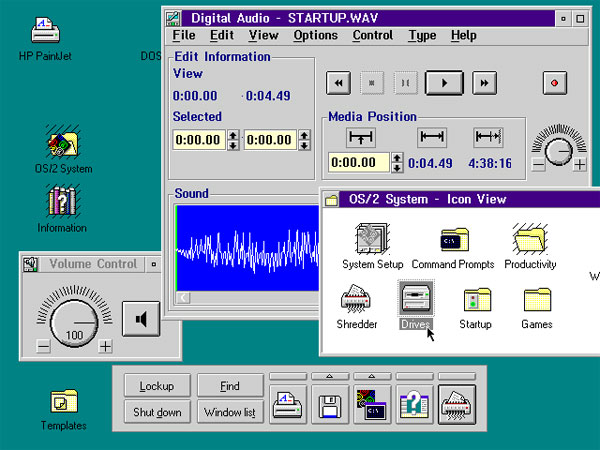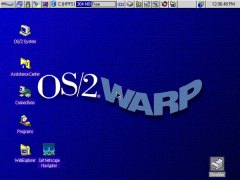The July 1987 issue of PC World magazine featured a centerfold (!) of Microsoft CEO Bill Gates proudly sporting an OS/2 button
Once again, OS/2 seemed to have an opportunity to go mainstream; once again, it didn’t happen. Windows users, by and large, were content to wait for Windows 95, and OS/2’s market share remained in the single digits.

GUIdebook
By then, I was working at PC World, where I edited a story for the February 1995 issue that attempted to rate the relative usability of Windows 95, Windows NT, OS/2 and Apple’s Mac OS. We brought people to our test center and asked them to perform typical tasks such as formatting a floppy disk and installing a fax modem. As they worked in each operating system, we observed through one-way mirrors, took copious notes and videotaped everything. (I’m exhausted again just remembering it.)
After conducting exit interviews with our test subjects, we converted their comments into numerical scores. The article gave OS/2 a rating of 2.8 — the worst of the bunch. “In almost every case,” we lamented, “the testers complained about how difficult it was to accomplish everyday tasks.” One of them, we noted, managed to accidentally destroy OS/2 by dragging vital system files to the “Shredder.”
(MORE: Bill Gates: The Wizard Inside the Machine)
Another of our guinea pigs, already an OS/2 fan, neatly summed up the software when he told us that it “thinks the way I think. [But] it’s not an end-user operating system; it’s a nerd operating system.”
Increasingly, evidence suggested that IBM was preparing to acknowledge that OS/2 was a lost cause. In August 1995, CEO Lou Gerstner was quoted by Laurence Zuckerman of the New York Times, who argued that operating systems were “the last war” and that it was “too late to go after the desktop.” The same month, IBM employee Dave Barnes, responsible for evangelizing OS/2, admitted to Peter Lewis of the Times that he was installing Windows 95 on his own home PCs. Barnes also compared OS/2 to Sony’s ill-fated Betamax.
As Lewis recalls:
I had received a review copy of OS/2 from IBM, but repeated attempts failed to get it to install properly. IBM’s PR people said they had no idea what the problem might be, as they had not heard of any other people having problems with it. I was living in Austin, so IBM dispatched its chief OS/2 evangelist to my home office to go through the installation with me.
Dave arrived. Very nice guy. But after a half-hour of futzing with my system, he said, “I just can’t do this any more.” Even John Akers (former chairman of IBM) was unable to get the new version of OS/2 installed properly on his home PC and had to have someone sent over to install it for him, he said. It wasn’t ready for prime time, he said.
I reminded him the session was on the record. He kept going.
The day my column ran in the NYT, IBM’s CEO blasted me publicly for an assortment of reporting sins and for taking Dave’s comments out of context. I expected that. But then IBM released a statement by Dave saying his comments were taken out of context, which I can only assume he was compelled to say after IBM took him to the woodshed.
I called IBM PR and told them I had tape-recorded the entire conversation with their evangelist, and that if they persisted in accusing me of making things up and taking quotes out of context, I would be happy to print the exact transcript.
They immediately stopped blasting me and the NYT.
At the time, OS/2 fans were outraged by press coverage such as the Zuckerman and Lewis stories and believed IBM when it said it was committed to the software’s future. Later, in his 2002 memoirs, CEO Gerstner revealed that the company was already plotting to wind down the OS/2 business when it released Warp.
The Fans Go Wild
OS/2 may have stubbornly refused to become a breakout hit, but it would be grossly misleading to suggest that nobody liked it. Actually, the people who did appreciate OS/2 loved it with an intensity that was unknown in the Windows world.
Much of that love was channeled into an organization called Team OS/2, originally instigated by IBM but mostly made up of thousands of smitten users who were paid only in tchotchkes like T-shirts. As its FAQ explained:
Team OS/2 is a highly informal organisation dedicated to telling the world about the advantages of Operating System/2 (OS/2), an advanced operating system for personal computers. Faced with a large amount of ignorance and misinformation about OS/2, Teamers respond by demonstrating the operating system to others, and educating them about its strengths and weaknesses. Teamers are all volunteers with a genuine enthusiasm for OS/2 that translates into a wish to spread that enthusiasm to others.
“[T]he community was so wonderful,” remembers Esther Schindler, an alumna who was also involved in the Phoenix OS/2 Society, a user group with members in 28 countries. “We felt as though we were making a difference. We were keeping people from automatically moving to the always late, overpromised and underdelivered Windows 95.” She calls the grassroots efforts of teamers such as Vicci Conway and Janet Gobeille “social media 15 years before it had a name.”
Team OS/2 members and other admirers of the software descended on trade shows, corresponded with publications that covered OS/2 (pro or con) and generally spread the word. As the FAQ’s cranky reference to a “large amount of ignorance and misinformation” suggests, they often behaved like they were on a crusade, leading to a zealousness that was occasionally scary if you were an unbeliever. Tech journalists discovered that it was difficult to write about the software without incurring wrath: one of my bosses told me that only Amiga owners rivaled OS/2 users for their maniacal missionary zeal.
I learned that for myself after I wrote what I thought was a mostly sympathetic story on OS/2. One user wrote a letter of complaint that compared me to Norman Bates hitting OS/2 in the back of the head with a shovel — a missive that stands as the finest attack on my professionalism that I’ve ever received. (On some level, I’ll be disappointed if this article doesn’t get any comments accusing it of being insufficiently appreciative of OS/2.)
The Long Goodbye

GUIdebook
In September 1996, IBM introduced OS/2 Warp 4, formerly code-named “Merlin.” It improved Warp 3’s interface and added features like built-in voice recognition. But IBM, which was already conspiring to exit the PC operating-system business, released it only grudgingly.
“John W. Thompson, the I.B.M. general manager in charge of the software, implied in an interview last week that the company had little choice but to continue supporting OS/2 because I.B.M.’s most important business customers still use it,” reported Zuckerman of the Times. “But the company has all but conceded that OS/2 will not compete for users in the consumer market.”
“By the time OS/2 Warp 4 came along, the company was no longer behind it,” agrees Esther Schindler. “They had publicly said they were going to do such-and-so, but at the top levels their hearts weren’t in it. And one by one, they dismantled what they had spent at least a decade building … Team OS/2 fell apart too, because how could we believe in their product if they didn’t?”


